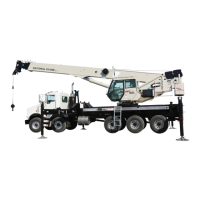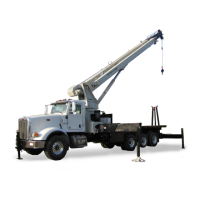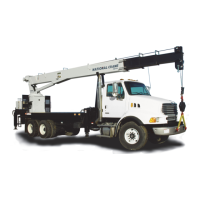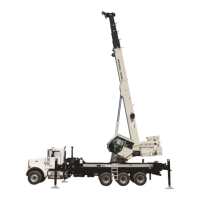National Crane 3-29-2018 Control # 610-00 2-27
NBT40-1 SERIES OPERATOR MANUAL SAFETY INFORMATION
recommendations in the Manitowoc Crane Care
Maintenance and Inspection Manual. Any questions
regarding procedures and specifications should be directed
to your National Crane distributor.
Service and Repairs
Service and repairs to the equipment must only be
performed by a qualified person. All service and repairs must
be performed in accordance with manufacturer’s
recommendations, this manual, and the service manual for
this machine. If there is any question regarding maintenance
procedures or specifications, contact your National Crane
distributor for assistance.
Qualified person is defined as one who by reason of
knowledge, training and experience is thoroughly familiar
with the equipment’s operation and required maintenance as
well as the hazards involved in performing these tasks.
Training and qualification of maintenance and repair
personnel are equipment owner’s responsibility.
Any modification, alteration, or change to equipment which
affects its original design and is not authorized and approved
by National Crane is strictly prohibited. All replacement
parts must be National Crane approved. Such action
invalidates all warranties and makes the owner/user liable
for any resultant accidents.
Hydraulic Fluid:
• Do not use your hand or any part of your body to check
for hydraulic fluid leaks when the engine is running or
the hydraulic system is under pressure. Fluid in the
hydraulic system can be under enough pressure that it
will penetrate the skin, causing serious injury or death.
Use a piece of cardboard, or piece of paper, to search
for leaks. Wear gloves to protect your hands from
spraying fluid.
• If any hydraulic fluid is injected into the skin, obtain
medical attention immediately or gangrene may result.
• Do not attempt to repair or tighten any hydraulic hose or
fitting while the engine is running, or when the hydraulic
system is under pressure.
• Never disconnect any hydraulic lines unless the boom is
fully lowered, the engine is shut off, and the hydraulic
pressure is relieved. To relieve hydraulic pressure, stop
the engine and move the hydraulic controls in both
directions several times.
• Hot hydraulic fluid will cause severe burns. Wait for the
fluid to cool before disconnecting any hydraulic lines.
• Hydraulic fluid can cause permanent eye injury. Wear
appropriate eye protection.
Moving Parts:
• Do not place limbs near moving parts. Amputation of a
body part may result. Turn off the engine and wait until
the fan and belts stop moving before servicing
equipment.
• Pinch points, which result from relative motion between
mechanical parts, are areas of the machine that can
cause personal injury or death. Do not place limbs or
your body in contact with pinch points either on or
around the machine. Care must be taken to prevent
motion between pinch points when performing
maintenance and to avoid such areas when movement
is possible.
• Do not allow persons to stand near extending or
lowering outriggers. Foot crushing could occur
Before performing any maintenance, service or repairs on
the equipment:
• The boom should be fully retracted and lowered and the
load placed on the ground.
• Do not get under a raised boom unless the boom is
blocked up safely. Always block up the boom before
doing any servicing that requires the boom to be raised.
• Stop the engine and disconnect the battery.
• Controls should be properly tagged. Never operate the
equipment if it is tagged-out nor attempt to do so until it
is restored to proper operating condition and all tags
have been removed by the person(s) who installed
them.
After maintenance or repairs:
• Replace all guards and covers that have been removed.
• Remove all tags, connect the battery, and perform a
function check of all operating controls.
• Consult with Manitowoc Crane Care to determine if load
testing is required after a structural repair is performed.
Lubrication
The equipment must be lubricated according to the
manufacturer’s recommendations for lubrication points, time
intervals, and types. Lubricate at more frequent intervals
when working under severe conditions.
WARNING
Fall Hazard!
Working at elevated heights without using proper fall
protection can result in severe injury or death.
Always use proper fall protection as required by local,
state or federal regulations.

